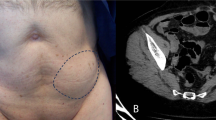Abstract
We report on a new method for the repair of spigelian hernia, in which we combined the step-by-step local anesthesia and open preperitoneal mesh repair techniques. After initial infiltration of local anesthetics, we incised the attenuated fascia and slightly enlarged the fascial defect to facilitate easy return of hernial content into the abdominal cavity. We injected preperitoneally, in a radial fashion around the peritoneal sac, more saline solution, consisting of 1:200,000 epinephrine (g:g) and ⅓ bupivacain (v:v). We dissected the peritoneum away from the anterior abdominal wall to create a preperitoneal pocket of sufficient size. We spread open a 9×9-cm polypropylene mesh in the area, as if we were doing a GPRVS of Stoppa. We followed up our four patients for an average of 32 months. All four cases had an uneventful recovery and were discharged in an average of 3.5 days. They returned to normal daily activity on the 9th day after surgery. We suggest that the preperitoneal mesh repair of a spigelian hernia under local anesthesia is a simple and feasible technique with favorable early and late postoperative results and deserves further investigation in larger series.


Similar content being viewed by others
References
Losanoff JE, Richman BW, Jones JW (2002) Spigelian hernia in a child: case report and review of the literature. Hernia 6:191–193
Moreno-Egea A, Flores B, Girela E, Martin JG, Aguayo JL, Canteras M (2002) Spigelian hernia: bibliographical study and presentation of a series of 28 patients. Hernia 6:167–170
Rogers FB, Camp PC (2001) A strangulated Spigelian hernia mimicking diverticulitis. Hernia 5:51–52
Nursal TZ, Kologlu M, Aran O (1997) Spigelian hernia presenting as an incarcerated incisional hernia. Hernia 1:149–150
Sanchez-Montes I, Deysine M (1998) A new repair technique using preshaped polypropylene umbrella plugs. Arch Surg 133:670–672
Fisher BL (1994) Video-assisted Spigelian hernia repair. Surg Laparosc Endosc 4:238–240
Moreno-Egea A, Carrasco L, Girela E, Martin JG, Aguayo JL, Canteras M (2002) Open vs laparoscopic repair of spigelian hernia. Arch Surg 137:1266–1268
Malazgirt Z, Ozkan K, Dervisoglu A, Kaya E (2000) Comparison of Stoppa and Lichtenstein techniques in the repair of bilateral inguinal hernias. Hernia 4:264–267
Solorzano CC, Minter RM, Childers TC, Kilkenny JW, Vauthey JN (1999) Prospective evaluation of the giant prosthetic reinforcement of the visceral sac for recurrent and complex bilateral inguinal hernias. Am J Surg 177:19–22
Amid PK, Shulman AG, Lichtenstein IL (1994) Local anesthesia for inguinal hernia repair step-by-step procedure. Ann Surg 220:735–737
Stoppa R (1995) The preperitoneal approach and prosthetic repair of groin hernias. In: Nyhus LM, Condon RE (eds) Hernia J.B.Lippincott, Philadelphia, pp 188–210
Melzack R (1987) The short-form McGill Pain Questionnaire. Pain 30:191–197
Larson DW, Farley DR (2002) Spigelian hernias: repair and outcome for 81 patients. World J Surg 26:1277–1281
Losanoff JE, Jones JW, Richman BW (2001) Recurrent Spigelian hernia: a rare cause of colonic obstruction. Hernia 5:101–104
Rutkow IM, Robbins AW (1993) ''Tension-free" inguinal herniorrhaphy: a preliminary report on the "mesh plug" technique. Surgery 144:3–8
Shulman AG, Amid PK, Lichtenstein IL (1994) Patch or plug for groin hernia-which? Am J Surg 167:331–336
Kasirajan K, Lopez J, Lopez R (1997) Laparoscopic technique in the management of Spigelian hernia. J Laparoendosc Adv Surg Tech A 7:385–388
DeMatteo RP, Morris JP, Broderick G (1994) Incidental laparoscopic repair of a spigelian hernia. Surgery 115:521–522
Amendolora M (1998) Videolaparoscopic treatment of spigelian hernias. Surg Laparosc Endosc 8:136–139
Gedebou TM, Neubauer W (1998) Laparoscopic repair of bilateral spigelian and inguinal hernias. Surg Endosc 12:1424–1425
Carter JE, Mizes C (1992) Laparoscopic diagnosis and repair of spigelian hernia: report of a case and technique. Am J Obstet Gynecol 167:77–78
Barie PS (1994) Planned laparoscopic repair of a spigelian hernia using a composite prosthesis. J Laparoendosc Surg 4: 359–363
Goodney PP, Birkmeyer CM, Birkmeyer JD (2002) Short-term outcomes of laparoscopic and open ventral hernia repair: a meta-analysis. Arch Surg 137:1161–1165
Liem MS, van der Graaf Y, Zwart RC, Geurts I, van Vroonhoven TJ (1997) A randomized comparison of physical performance following laparoscopic and open inguinal hernia repair. Br J Surg 84:64–67
Author information
Authors and Affiliations
Corresponding author
Rights and permissions
About this article
Cite this article
Malazgirt, Z., Dervisoğlu, A., Polat, C. et al. Preperitoneal mesh repair of spigelian hernias under local anesthesia: description and clinical evaluation of a new technique. Hernia 7, 202–205 (2003). https://doi.org/10.1007/s10029-003-0153-x
Received:
Accepted:
Published:
Issue Date:
DOI: https://doi.org/10.1007/s10029-003-0153-x




